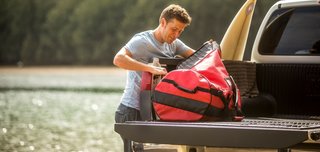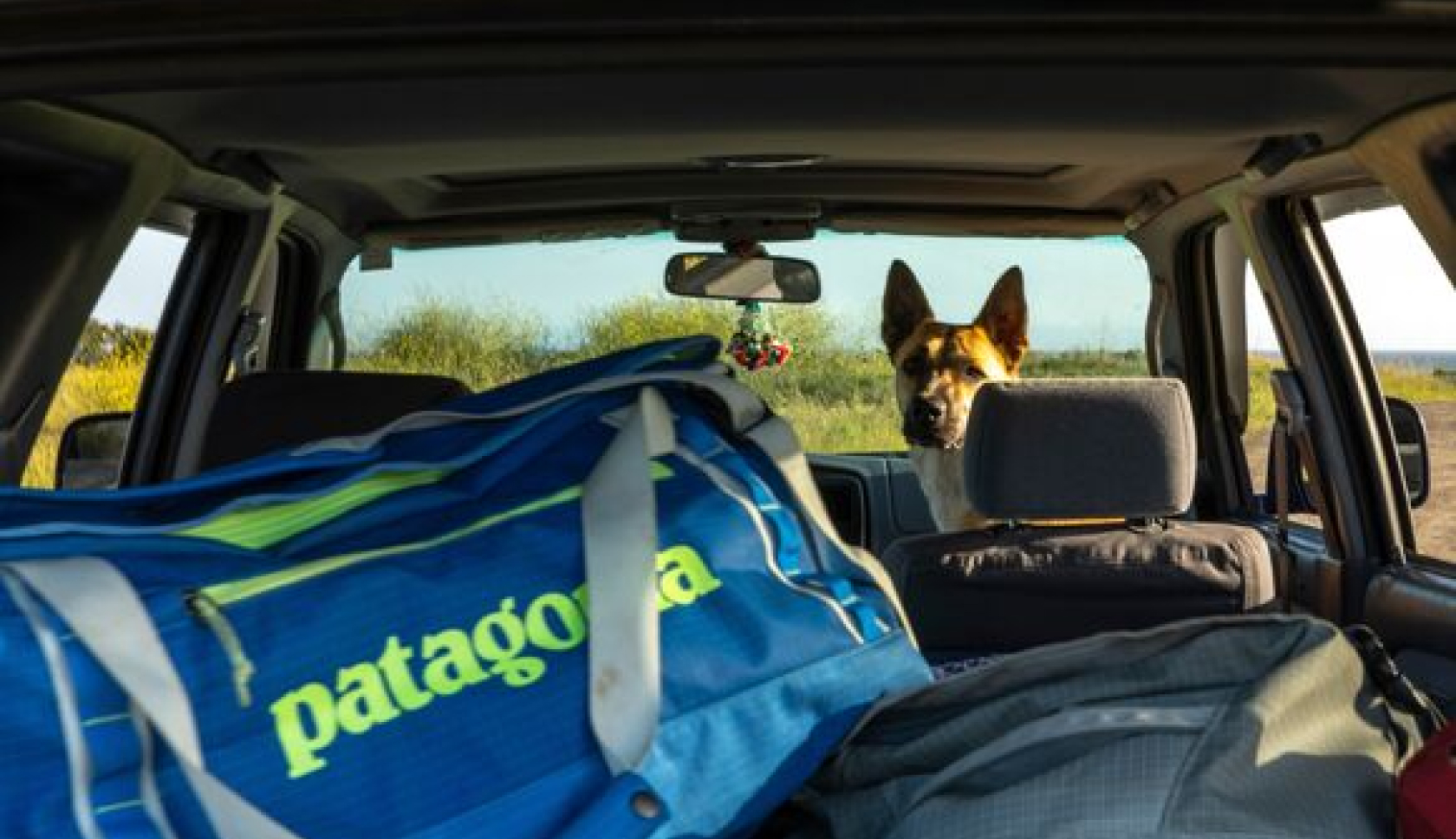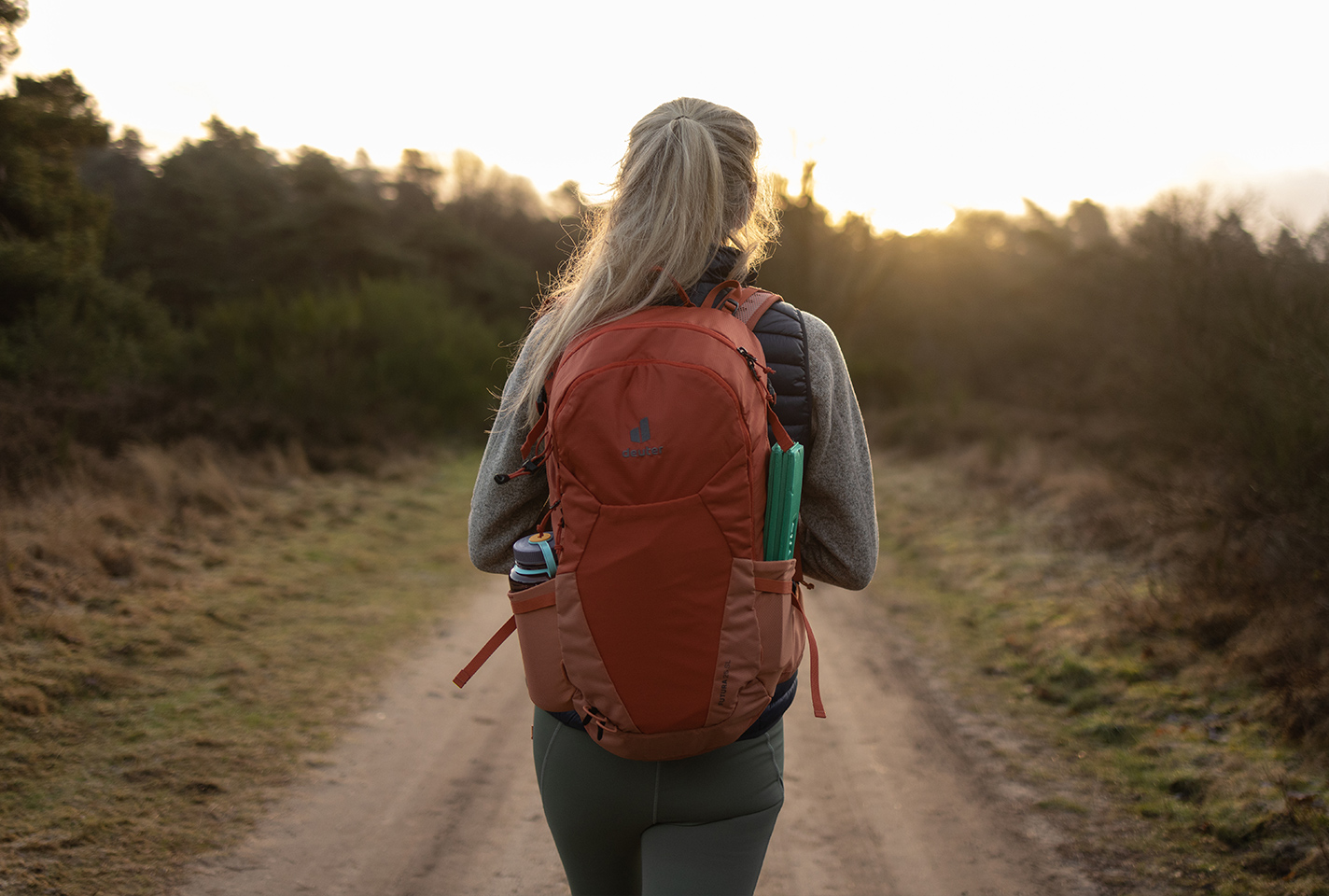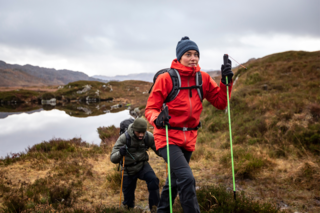Whether it’s a city break, European escape or trekking in a far-flung location, the right luggage makes packing for your trip much easier. To help you make the right choice, we take you through the different types of luggage available, from duffels to rucksacks, to ensure that you’re ready for any adventure. Plus, we’ll take a look at some of the essential accessories to look out for to make every trip run more smoothly.

Travel Luggage Guide

Duffel Bags
Duffel bags are a classic and highly adaptable option for travelers, especially if you’re not planning to cover long distances on foot. Their practical design and robust build make them a favorite for a wide range of trips, from weekend getaways to rugged expeditions.
Key Features of Duffel Bags
- Variety of Sizes: Duffel bags come in a range of capacities, typically from 30L for short trips to 120L for extended adventures. You can easily choose a size that matches the length and demands of your journey.
- Easy to Carry: Most duffels are equipped with both shoulder straps and grab handles, allowing for flexible carrying options. Some models even feature backpack-style straps for short hauls.
- Spacious and Flexible: The roomy interior is perfect for packing bulkier items like snow boots, camping gear, or sports equipment. The soft sides mean you can squeeze your bag into tight spaces where a rigid suitcase wouldn’t fit.
- Simple Packing and Access: Many duffel bags feature wide, dual-sided openings, making it easy to pack and unpack your belongings. This design is especially handy when you need to grab something quickly.
Durability and Protection
- Built to Last: Duffel bags are known for their ruggedness. They’re often made from tough, abrasion-resistant materials, making them ideal for rough handling and outdoor adventures.
- Weather Resistance: Many duffels are constructed with waterproof or water-resistant fabrics, offering protection for your gear if you get caught in the rain.
When to Choose a Duffel Bag
Duffel bags are ideal if:
- You’re travelling by car, train, or plane and won’t be walking long distances with your bag.
- You need to pack irregularly shaped or bulky items.
- You want a bag that can be easily compressed to fit into small or awkward storage spaces.
Things to Consider
While duffel bags have many advantages, there are a few potential drawbacks:
- Not for Long Distances: Duffels are best suited for situations where you don’t need to carry them far. Carrying a heavy duffel over long distances can be uncomfortable, even with padded straps.
- Organisation Challenges: The open, single-compartment design makes it easy to toss items in, but it can be difficult to keep things organised. Packing cubes or small pouches can help, especially if you’ll be unpacking and repacking frequently.
Duffel bags are a durable, spacious, and versatile luggage choice, perfect for travelers who value flexibility and toughness over strict organisation or long-distance carrying comfort. If your trip involves varied gear or limited storage space, a duffel bag could be your ideal travel companion.
Wheeled Luggage
Wheeled luggage has become a go-to choice for many travellers, offering a convenient and efficient way to transport your belongings-especially when you’re navigating airports, train stations, or city streets. Here’s what makes wheeled luggage a standout option and some things to consider before you pack your bags.
Key Benefits of Wheeled Luggage
- Effortless Transport: Wheeled luggage takes the strain off your muscles and joints, making it far easier to move heavy loads, particularly if you’re also carrying a second bag such as a backpack or tote.
- Ideal for Smooth Surfaces: Airports, hotels, and paved walkways are perfect environments for wheeled cases, allowing you to glide your luggage along with minimal effort.
- Increased Carrying Capacity: The structured design often allows you to pack more, and the organised compartments make it easy to separate clothes, shoes, and accessories.
Types of Wheeled Luggage
- Two-Wheel Cases (Rollers):
- Practical and durable.
- Designed to be pulled behind you.
- Better suited for rougher terrain than four-wheelers but require tilting to move.
- Four-Wheel Cases (Spinners):
- Offer greater stability and maneuverability.
- Can be pushed or pulled in any direction, making them easy to navigate through crowded spaces.
- Can still be tilted and used on two wheels if needed.
- Hybrid Wheeled Rucksack:
- Combines the benefits of wheels with the versatility of a backpack.
- Retractable handle and stowable harness allow you to switch from rolling to carrying when faced with stairs, cobblestones, or uneven ground.
Considerations and Limitations
While wheeled luggage is incredibly convenient, there are a few factors to keep in mind:
- Weight and Structure: The rigid frame and wheels add extra weight compared to duffel bags, which can be a concern if you’re trying to travel light or meet strict airline weight limits.
- Less Flexibility: Wheeled cases are harder to compress or squeeze into tight storage spaces, such as packed car boots or overhead bins on crowded trains.
- Not Ideal for All Terrain: Rough, unpaved surfaces, sand, or muddy paths can make wheeled luggage difficult to maneuver. In these situations, a backpack or duffel may be more practical.
When to Choose Wheeled Luggage
Wheeled luggage is best suited for:
- Urban travel, business trips, and city breaks.
- Trips where you’ll be moving between hotels, airports, and paved areas.
- Travelers who need to carry more or prefer organised packing.
Wheeled luggage offers unmatched convenience and ease of transport in the right environments, making it a smart choice for many travel scenarios. If you anticipate smooth surfaces and want to avoid carrying heavy loads, a wheeled case is likely your best bet. However, if you expect tight storage spaces or rough terrain, consider a duffel or hybrid bag to complement your travel style.

Rucksacks
Rucksacks, especially those designed for hiking and travel, are among the most versatile pieces of luggage you can choose for your adventures. Whether you’re trekking through remote landscapes, hopping between cities, or embarking on a gap year, a well-chosen rucksack can make your journey smoother and more comfortable.
Key Features of Travel Rucksacks
- Spacious and Organised: Rucksacks offer plenty of space for all your essentials, with multiple compartments, pockets, and technical features to help you stay organised on the go.
- Durability: Built to withstand rugged conditions, most hiking rucksacks are made from tough, weather-resistant materials that can handle the wear and tear of travel.
- Comfort-Focused Design:
- Many rucksacks feature a breathable back panel, which helps keep you cool and comfortable during long walks or hikes.
- Padded shoulder straps and hip belts distribute weight evenly, reducing strain on your back and shoulders.
Practical Advantages
- Hands-Free Travel: Carrying your belongings on your back leaves your hands free for maps, snacks, or taking photos-ideal for active travellers or those navigating busy transport hubs.
- Great for Remote or Active Trips: Rucksacks are the best choice if you’ll be moving around a lot, especially in remote areas where wheeled luggage isn’t practical.
- Smart Internal Organisation:
- Internal sections and dividers help you separate clean and dirty clothes, muddy shoes, and other gear.
- Many models include padded compartments for laptops or tablets, as well as hidden pockets for valuables and extra security features.
Things to Consider
- Packing and Access: Traditional top-loading hiking rucksacks can be tricky to pack and unpack, especially if you need to access items at the bottom. If your trip involves frequent stops or changing accommodations, consider a travel rucksack that zips open fully, like a suitcase, for easier access.
- Daily Unpacking: If you’re visiting multiple destinations, be prepared to unpack and repack your bag regularly. Packing cubes or stuff sacks can help keep things organised and speed up the process.
Expert Advice and Fitting
- Get the Right Fit: A properly fitted rucksack is crucial for comfort and injury prevention. Visit one of our stores for a personalised rucksack fitting with our in-store experts-find your local store here.
- Learn More: Check out our comprehensive rucksack fitting guide to ensure you choose the right size and style for your needs.
In summary, rucksacks are a top choice for travellers who value flexibility, organisation, and comfort-especially if your adventures will take you off the beaten path or require lots of movement. With the right features and a perfect fit, your rucksack will be your trusty travel companion for years to come.
Daypacks
Daypacks are the perfect companion for travellers who want a smaller, versatile bag for day-to-day adventures or as a carry-on. Compact yet highly functional, a well-chosen daypack keeps your essentials close at hand-whether you’re sightseeing, hiking, or navigating airports.
Why Choose a Daypack?
A daypack is essentially a smaller backpack, typically ranging from 10 to 35 litres in capacity. It’s designed to carry just what you need for a day out, making it ideal for:
- Day hikes or short walks
- Urban exploring and sightseeing
- Commuting or gym trips
- Carry-on baggage for flights
Key Features and Benefits
- Comfort and Ergonomics: Like larger rucksacks, quality daypacks are built with comfort in mind. Look for padded shoulder straps, breathable back panels, and adjustable sternum or hip straps for stability.
- Organisation: Many daypacks feature multiple compartments, side pockets, and internal sleeves for water bottles, laptops, or hydration reservoirs. This helps keep your kit organised and easy to access.
- Technical Extras: Some models include features like hydration bladder compatibility, lockable zippers for security, and compression straps to stabilise your load.
- Versatility: Daypacks are incredibly adaptable. Use them for day trips, as a personal item on flights, or even as your main bag if you’re a minimalist traveler. Some packable daypacks can be folded down small enough to fit in your jacket pocket or suitcase, ready to use when needed.
Tips for Choosing the Right Daypack
- Size Matters: Select a daypack that’s big enough to carry your daily essentials-think water, snacks, an extra layer, and valuables-but not so large that it becomes cumbersome or heavy.
- Travel-Friendly Design: If you’re using your daypack as carry-on luggage, avoid models with rigid frames, as these add bulk and may not fit easily into overhead compartments.
- Packability: Consider a packable or compressible daypack if you want to stash it inside your main luggage and use it only when needed.
When to Use a Daypack
- Leave your main bag at your accommodation and take just what you need for the day.
- Use it as your personal item on flights, keeping travel documents, electronics, and snacks within easy reach.
- Ideal for excursions, city tours, or spontaneous adventures where flexibility is key.
A good daypack is a travel essential-lightweight, comfortable, and packed with features to keep you organised on the go. Choose one that fits your needs, and you’ll wonder how you ever travelled without it.
Essential Accessories for Your Travel Luggage
Packing Solutions
Keeping your luggage organised can save you time and hassle throughout your trip. Consider these options:
- Packing Cubes:
- Help keep your clothes, tech, and shoes neatly separated and easy to find.
- Available in a variety of sizes, so you can customise your packing system to suit your needs.
- Make packing, re-packing, and unpacking a breeze-especially useful if you’re moving between multiple destinations.
- Great for keeping clothes folded and wrinkle-free, or for keeping dirty and clean items apart.
Security
Protecting your belongings is a top priority while travelling. Look for these security features and accessories:
- Interlocking Zips:
- Allow you to use a padlock to secure your bag, deterring opportunistic thieves.
- Combination Locks:
- Eliminate the risk of losing small keys while still providing strong security.
- TSA-Approved Locks:
- Essential for travel to and within the USA, as airport authorities can open your lock without damaging it during security checks.
Dry Bags
If your travels will take you to wet or adventurous environments, dry bags are a smart addition:
- Waterproof Protection:
- Keep your valuables, electronics, and clothes dry even if your main bag gets wet.
- Variety of Sizes:
- Use smaller dry bags to separate kit inside your rucksack or larger ones for bulkier items.
- Organisation:
- Double as an internal organiser, helping you keep different types of gear separated and easy to access.
Rucksack Accessories
Rucksacks are often tossed around during travel, so a few extra accessories can help prolong their life and keep your gear safe:
- Rucksack Cover:
- Protects your bag from rain, dirt, and rough handling.
- Prevents straps from getting caught or damaged during transit.
- Adds an extra layer of security, especially if it includes lockable zips or reinforced fabric.
- Additional Security Features:
- Look for rucksacks with built-in lockable zippers or hidden pockets for valuables.
Additional Handy Accessories
- Luggage Tags:
- Clearly label your bags to avoid mix-ups and make lost luggage easier to recover.
- Compression Sacks:
- Great for reducing the bulk of sleeping bags or bulky clothing.
- Travel Bottles:
- Refillable bottles for toiletries that meet airline liquid restrictions.
- Cable Organisers:
- Keep chargers, headphones, and tech accessories tidy and tangle-free.
By investing in the right travel accessories, you’ll keep your luggage organised, secure, and protected-making your journey smoother and more enjoyable from start to finish.

Travel Luggage FAQs
Select luggage based on trip length and airline requirements. For short trips or carry-on only, a 40–45L backpack or small wheeled suitcase is ideal. For longer journeys, a 60–80L suitcase or duffel offers more space. Always check your airline’s size and weight limits before packing.
Suitcases with wheels are great for urban travel and smooth surfaces, offering easy organisation. Backpacks are better for trips involving stairs, rough terrain, or frequent moves, as they’re easier to carry and more versatile.
Use TSA-approved padlocks on zippers and consider luggage with lockable compartments. Keep valuables, documents, and electronics in your carry-on or daypack. Always label your luggage with your contact details and use a luggage tag for easy identification.
Pack essentials like travel documents, medications, electronics, chargers, a change of clothes, toiletries in travel-size containers, and valuables in your carry-on. Include items for comfort such as a travel pillow, eye mask, snacks, and a reusable water bottle.
Use packing cubes or compression bags to separate clothing, toiletries, and accessories. Place heavier items at the bottom and keep frequently used items near the top or in exterior pockets. This helps maximise space and keeps your belongings easily accessible.
Look for durable materials, sturdy zippers, smooth-rolling wheels, and comfortable handles. Water-resistant fabrics, expandable compartments, and reinforced corners add extra protection. Interior pockets and compression straps help keep items organised and secure.
Yes, a daypack is useful for carrying daily essentials, valuables, and items you want to keep handy during flights or excursions. It complements your main luggage and is ideal for sightseeing, hikes, or city exploration.
Related Articles

Let us know you agree to cookies
We use marketing, analytical and functional cookies as well as similar technologies to give you the best experience. Third parties, including social media platforms, often place tracking cookies on our site to show you personalised adverts outside of our website.
We store your cookie preferences for two years and you can edit your preferences via ‘manage cookies’ or through the cookie policy at the bottom of every page. For more information, please see our cookie policy.




